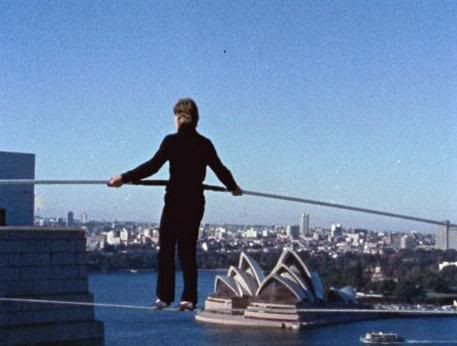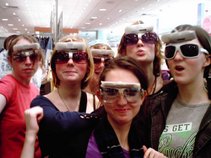
Yeah, I know. Long time no blog. There's no particular excuse or reason, other than general ambivalence towards it, but I had to post about the most recent film I saw in theaters, James Marsh's film, Man On Wire. Give and take a Wall-E here and a The Visitor there, this is one of the best films I've seen all year. Come to think of it, all three have something in common. The critically-adored Pixar smash, the low-budget immigration story buried inside Tom McCarthy's character based second film and the award winning documentary about wire-walker Philippe Petit all share a common feeling. Watching each of the three, I felt the urgent need pressed upon me to really appreciate life, to take chances, to create art. Believe me, I know how cheesy this all sounds. But watching Philippe Petit dancing across the empty space between the twin towers, his only support a tiny cable, I felt truly exhilarated. There's a beautiful moment when he spots a policeman on the top of one of the towers, urging him to come back to safety, and Petit's face breaks into this beatific smile. It's hilarious, extraordinary, terrifying (at this moment, he's 400 metres up in the air).
The basic story has been told and retold to death. Petit, a French street performer and self-taught wire walker (a much classier term than tightrope walker, don't you think?) became obsessed with the World Trade Centre towers as they were being built. He followed their progress in the French newspapers, all the while formulating a plan in the back of his mind. He wanted to walk across them. He needed to walk across them. The towers became a full blown obsession for him. So he acted on his obsession: gathering a town, scoping out the towers, reading, sketching, making diagrams. Insane preparations. He rigged up a mock cable in a Frencg field and got a bunch of friends to jump up on down on it as he crossed, to stimulate the probable wind conditions. He had notebooks filled with complex instructions and doodles. He made contacts inside the WTC, so his team could have mock I.D. cards. 6 years of intense planning, all culminating in 45 minutes on a clear August morning in 1974. Having snuck up to the highest floor, hidden from the guards and rigged the cable across the two towers (an incredibly complex manouevre), early birds in New York city were treated to the spectacle. Petit crossed back and forth 8 times, pausing at different points to kneel, lie down and look up at the clouds and, insanely, to actually look straight down. I'll repeat that: he knelt on the wire and gazed down into New York city, 400 metres above it. I get dizzy climbing the stairs into the attic!
It's an interestingly constructed film, mixing talking heads, archive footage and artful reconstructions in order to dazzle the audience. Petit himself, now 59, is a lively, engaging storyteller. His wide eyed retelling of his escapades are amusing, but his gleeful joie de vivre is set off by some of the other contributers. His former girlfriend, Annie Allix and one time best friend, Jean-Louis Blondeau, both provide moving accounts. They are both impressed and saddened by Petit. After the feat, his relationship with both people fizzled out; perhaps a necessity after collaborating on something that intense. It's one of the things I liked most about the documentary, its focus on the intense planning of the 'before' and the bittersweet letdown of the 'after', as well as the glorification of the event itself. Go see it, please. It's the most thrilling, moving paean to art and the creative impulse that you'll see in the cinema all year.
More on Petit:
I observed the tightrope 'dancer'—because you couldn't call him a 'walker'—approximately halfway between the two towers. And upon seeing us he started to smile and laugh and he started going into a dancing routine on the high wire....And when he got to the building we asked him to get off the high wire but instead he turned around and ran back out into the middle....He was bouncing up and down. His feet were actually leaving the wire and then he would resettle back on the wire again....Unbelievable really....[E]verybody was spellbound in the watching of it
- the eyewitness report of Sgt. Charles Daniels, the officer assigned to coax Petit down.
'Many people use the words "death defying" or "death wishing" when they talk about wire-walking. Many people have asked me: "So do you have a death wish?" After doing a beautiful walk, I feel like punching them in the nose. It's indecent. I have a life wish.'
- in his own words. From an interview with the Observer.
I also discovered that Paul Auster (i.e. my favourite writer) has a connection to Petit! Living in Paris in the early seventies, he encountered Petit as a street performer. Captivated, he followed his career with interest, which ended up with a meeting between the two men. Auster helped Petit with getting his book, On The High Wire, published, and he also translated it into English from the French original. In the preface to the book, Auster writes a piece on his appreciation of Petit and I have it in my Collected Prose. Here's a short excerpt, describing his first sighting of Petit. He taps into what's so magnetic about the man:
"Unlike other street preformers, he did not play to the crowd. Rather, it was somehow as though he had allowed the audience to share in the working of his thoughts, had made us privy to some deep, inarticulate obsession within him. Yet there was nothing overly personal about what he did. Everything was revealed metaphorically, as if at one remove, through the medium of the performance. His juggling was precise and self-involved, like some conversation he was holding with himself. He elaborated the most complex combinations, intricate mathematical patterns, arabesques of nonsensical beauty, while at the same time keeping his gestures as simple as possible. Throught it all, he managed to radiate a hypnotic charm, oscilliating somewhere between demon and clown. No one said a word. It was as though his silence were a command for others to be silent as well. The crowd watched, and after the performance was over, everyone put money in the hat. I realised that I had never seen anything like it before."



500 comments:
«Oldest ‹Older 801 – 500 of 500Post a Comment